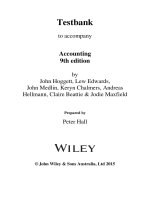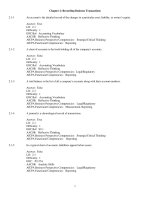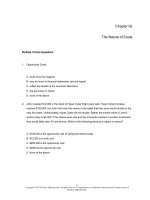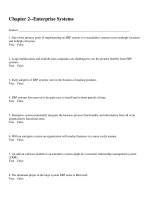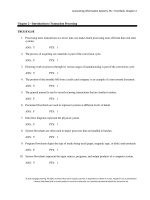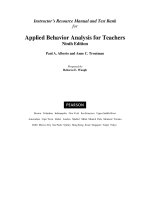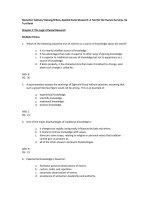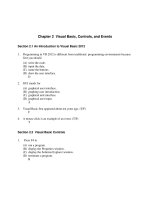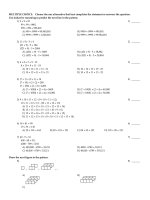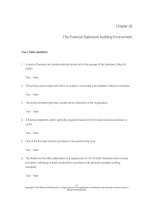Computer concepts illustrated introductory 9th edition parsons test bank
Bạn đang xem bản rút gọn của tài liệu. Xem và tải ngay bản đầy đủ của tài liệu tại đây (256.94 KB, 11 trang )
Unit A: Computer and Internet Basics
TRUE/FALSE
1. Cars and appliances include digital electronics.
ANS: T
PTS: 1
REF: Concepts 2
2. Usually when people talk about computers, they are talking about a PC.
ANS: T
PTS: 1
REF: Concepts 2
3. The term software refers not only to the internal parts of the computer, but also to the peripheral
devices.
ANS: F
PTS: 1
REF: Concepts 2
4. All cell phones are examples of a personal computer.
ANS: F
PTS: 1
REF: Concepts 3
5. On any computer, the instructions that tell a computer how to carry out processing tasks are referred to
as apps.
ANS: F
PTS: 1
REF: Concepts 4
6. When you tell a computer what to do, you are providing input.
ANS: T
PTS: 1
REF: Concepts 4
7. After you save a document as a computer file, it is in storage.
ANS: T
PTS: 1
REF: Concepts 5
8. To turn off the computer, simply press the power switch.
ANS: F
PTS: 1
REF: Concepts 5
9. It is easy to get inside a tower case and swap parts.
ANS: T
PTS: 1
REF: Concepts 6
10. Only a workstation or mainframe can be configured to perform the work of a server.
ANS: F
PTS: 1
REF: Concepts 7
MODIFIED TRUE/FALSE
1. The digital convergence is an ongoing process of social, political, and economic change brought about
by digital technology. _________________________
ANS: F, revolution
PTS: 1
REF: Concepts 2
2. The system unit is the box that houses the most important parts of the computer system.
_________________________
ANS: T
PTS: 1
REF: Concepts 2
3. A(n) output device and computer work together to change information into a series of electronic
signals a computer can understand. _________________________
ANS: F, input
PTS: 1
REF: Concepts 3
4. Digitization is the process of converting text, numbers, sound, photos, and video into data that can be
processed by a computer. _________________________
ANS: T
PTS: 1
REF: Concepts 3
5. Memory is the area of a computer that holds data on a permanent basis when it is not immediately
needed for processing. _________________________
ANS: F, Storage
PTS: 1
REF: Concepts 5
6. Storage is an area of the computer that temporarily holds data waiting to be processed, stored, or
output. _________________________
ANS: F, Memory
PTS: 1
REF: Concepts 5
7. Most computers are equipped with a(n) mouse as the primary input device.
_________________________
ANS: F, keyboard
PTS: 1
REF: Concepts 8
8. A(n) application system is the master controller for all the activities that take place within a computer
system. _________________________
ANS: F, operating
PTS: 1
REF: Concepts 10
9. An operating system is an example of system software. _________________________
ANS: T
PTS: 1
REF: Concepts 10
10. A(n) blog is a collaborative Web site that allows people to add to and modify material posted by
others. _________________________
ANS: F, wiki
PTS: 1
REF: Concepts 15
MULTIPLE CHOICE
1. A machine that accepts input, processes and stores data, and produces output is called a(n) ____.
a. computer
c. word processor
b. device
d. PC
ANS: A
PTS: 1
REF: Concepts 2
2. A computer system includes which of the following?
a. hardware
c. peripheral devices
b. software
d. All of the above.
ANS: D
PTS: 1
3. PC stands for ____ computer.
a. peripheral
b. personal
ANS: B
PTS: 1
REF: Concepts 2
c. processor
d. portable
REF: Concepts 2
4. ____ refers to the electronic and mechanical parts of the computer.
a. System unit
c. Hardware
b. Software
d. All of the above.
ANS: C
PTS: 1
REF: Concepts 2
5. Digital cameras and media players are examples of ____ devices.
a. internal
c. peripheral
b. storage
d. input
ANS: C
PTS: 1
REF: Concepts 3
6. Word processing and antivirus programs are examples of ____.
a. peripherals
c. hardware
b. software
d. digital devices
ANS: B
PTS: 1
REF: Concepts 3
7. A computer processes information and sends it to a(n) ____ device.
a. peripheral
c. input
b. storage
d. output
ANS: D
PTS: 1
REF: Concepts 3
8. ____ is the trend to blend several technologies with distinct functions into a single product.
a. Digital convergence
c. Digitization
b. Digital evolution
d. Cloud computing
ANS: A
PTS: 1
REF: Concepts 3
9. Once information is input into a computer, it becomes ____.
a. data
b. output
ANS: A
c. memory
d. software
PTS: 1
REF: Concepts 4
10. The main processor in a computer is called the ____.
a. GUI
c. LAN
b. CPU
d. PC
ANS: B
PTS: 1
REF: Concepts 5
11. A(n) ____ is a named collection of data that exists on a storage medium.
a. disk
c. folder
b. drive
d. file
ANS: D
PTS: 1
REF: Concepts 5
12. The file ____ is composed of the period and characters to the right of the period.
a. name
c. type
b. location
d. extension
ANS: D
PTS: 1
REF: Concepts 5
13. All of the following are examples of portable computers EXCEPT ____.
a. desktops
c. netbooks
b. notebooks
d. tablets
ANS: A
PTS: 1
REF: Concepts 6
14. The case for a vertical system unit is often referred to as a ____.
a. box
c. desktop
b. tower
d. tablet
ANS: B
PTS: 1
REF: Concepts 6
15. The accompanying figure is an example of a(n) ____ computer.
a. all-in-one
c. tower
b. notebook
d. netbook
ANS: C
PTS: 1
REF: Concepts 6
16. The accompanying figure is an example of a(n) ____ computer.
a. all-in-one
c. tower
b. notebook
d. netbook
ANS: D
PTS: 1
REF: Concepts 6
17. The accompanying figure is an example of a(n) ____ computer.
a. tablet
c. notebook
b. tower
d. all-in-one
ANS: A
PTS: 1
REF: Concepts 6
18. A(n) ____ computer has a clamshell design, and opens and closes on a hinge.
a. tablet
c. notebook
b. tower
d. all-in-one
ANS: C
PTS: 1
REF: Concepts 6
19. A(n) ____ has a touch-sensitive screen, which can be used as a writing or drawing pad.
a. netbook
c. tablet
b. PDA
d. videogame console
ANS: C
PTS: 1
REF: Concepts 7
20. Examples of ____ computers are portable media players and smartphones.
a. handheld
c. netbook
b. tablet
d. mini-laptop
ANS: A
PTS: 1
REF: Concepts 7
21. Nintendo’s Wii and Microsoft’s Xbox are types of ____.
a. netbooks
c. tablets
b. PDAs
d. videogame consoles
ANS: D
PTS: 1
REF: Concepts 7
22. A(n) ____ drive works with CDs, DVDs, and BDs.
a. hard
c. magnetic
b. optical
d. flash
ANS: B
PTS: 1
REF: Concepts 8
23. A(n) ____ allows you to capture video images using your computer.
a. Web cam
c. digital camera
b. digital media player
d. All of the above.
ANS: A
PTS: 1
REF: Concepts 9
24. A network located in your home is an example of a(n) ____.
a. WAN
c. Internet
b. LAN
d. modem
ANS: B
PTS: 1
25. Linux is an example of a(n) ____.
a. operating system
b. computer platform
ANS: A
PTS: 1
REF: Concepts 9
c. GUI
d. handheld device
REF: Concepts 10
26. Which of the following is NOT true about computer platforms and operating systems?
a. If you have an Intel Mac you can install the Windows OS.
b. The PC platform is sometimes called the Windows platform
c. Linux is usually used instead of the Macintosh OS.
d. Two of the most important factors that define a computer’s platform are the processor and
the OS.
ANS: C
PTS: 1
REF: Concepts 10
27. The ____ is used for tasks such as starting programs and locating data files.
a. CPU
c. computer platform
b. operating system
d. application software
ANS: B
PTS: 1
REF: Concepts 10
28. A(n) ____, like the one in the accompanying figure, displays on-screen icons, menus, and buttons.
a. application software
c. operating system
b. Macintosh
d. GUI
ANS: D
PTS: 1
REF: Concepts 11
29. If you want to discuss a research topic with others in public, you can participates in a(n) ____.
a. instant message
c. Internet telephony
b. chat group
d. Skype session
ANS: B
PTS: 1
REF: Concepts 14
30. In the URL ____ is the Web protocol standard.
a. http
c. nps
b. www
d. htm
ANS: A
PTS: 1
REF: Concepts 13
31. In the URL ____ is the Web server name.
a. http
c. nps
b. www
d. htm
ANS: C
PTS: 1
REF: Concepts 13
32. In the URL ____ is the file extension.
a. http
c. nps
b. www.
d. htm
ANS: D
PTS: 1
REF: Concepts 13
33. Much of a program for a Web app runs on a distant computer, often called the ____.
a. cloud
c. network
b. system
d. search
ANS: A
PTS: 1
REF: Concepts 13
34. You can use a(n) ____ on a search site to describe the information you are trying to find.
a. URL
c. keyword
b. navigator
d. browser
ANS: C
PTS: 1
REF: Concepts 13
35. Several people who connect to the Internet and communicate in real time by typing comments to each
other is called a(n) ____.
a. chat group
c. VoIP
b. instant message
d. social network
ANS: A
PTS: 1
REF: Concepts 14
36. Additional recipients can be added to an e-mail via the Cc feature; Cc stands for ____ copy.
a. courier
c. computer
b. courtesy
d. chat
ANS: B
PTS: 1
REF: Concepts 14
37. All of the following are true EXCEPT ____.
a. e-mail is based on store-and-forward technology
b. a file that travels with an email message is called an email attachment
c. clicking Reply All sends your message to everyone who received the original message
including the Bcc recipients.
d. you can use to send a message to a number of people at the same time.
ANS: C
PTS: 1
REF: Concepts 14|17
38. The term ____ refers to a personal journal focusing on a single topic or a variety of topics.
a. wiki
c. grid
b. blog
ANS: B
d. MMS
PTS: 1
REF: Concepts 15
39. Which of the following activities is enabled by the resource shown in the accompanying figure?
a. social networking
c. grid computing
b. cloud computing
d. wiki usage
ANS: A
PTS: 1
REF: Concepts 15
40. ____ messages are typed messages you send using your smartphone or mobile device.
a. Public
c. Attached
b. Blog
d. Text
ANS: D
PTS: 1
REF: Concepts 15
COMPLETION
1. Digital ____________________ includes electronic devices such as computers and portable media
players, mobile phones, smartphones, tablet computers, and the like.
ANS: technology
PTS: 1
REF: Concepts 2
2. A keyboard or a mouse is an example of a(n) ____________________ device.
ANS: input
PTS: 1
REF: Concepts 3
3. A printer or a monitor is an example of a(n) ____________________ device.
ANS: output
PTS: 1
REF: Concepts 3
4. Sometimes when starting a computer you will be asked to enter a user ID and
____________________.
ANS: password
PTS: 1
REF: Concepts 4
5. A(n) ____________________ is a scaled-down version of notebook and offers more portability.
ANS: netbook
PTS: 1
REF: Concepts 7
6. A(n) ____________________ is a common input device designed to move and select on-screen
graphical objects and controls.
ANS: mouse
PTS: 1
REF: Concepts 8
7. Internet connections require a(n) ____________________.
ANS: modem
PTS: 1
REF: Concepts 9
MATCHING
Identify the correct answer from the list of choices.
a. Mainframe
d. USB flash drive
b. Supercomputer
e. Hard drive
c. Workstation
1.
2.
3.
4.
5.
A large and expensive computer capable of processing data for hundreds or thousands of users.
A removable storage device for a PC.
A primary storage device.
A powerful desktop computer, used for medical imaging and computer-aided design.
A computer used for breaking codes.
1.
2.
3.
4.
5.
ANS:
ANS:
ANS:
ANS:
ANS:
A
D
E
C
B
PTS:
PTS:
PTS:
PTS:
PTS:
1
1
1
1
1
REF:
REF:
REF:
REF:
REF:
Concepts 7
Concepts 8
Concepts 8
Concepts 7
Concepts 7
ESSAY
1. What are digitization, the digital revolution, and digital convergence, and how do they affect your life?
ANS:
Digitization is the process of converting text, numbers, sound, photos, and video into data that can be
processed by a computer. The advantage of digital images and sounds is that they can be easily stored,
copied, and shared. Digital images have changed the photographic industry. Digital cameras have
replaced film cameras. Digital imaging used in medical tests has had profound effects in the healthcare
industry. Digital video is responsible for special effects in movies, new trends in 3D animation,
portable video, and consumer interest in home video. Digital sound transformed the way music is
marketed, sold, purchased, and played. Human speech can also be digitized. For example, when you
call a business for help or information, digitized voice telephone systems understand and respond to
your spoken words. GPS devices tell you the directions as you drive.
The digital revolution is the process of social, political, and economic change brought about by digital
technology, such as computers and the Internet. The digital revolution affects people’s lives in that it
influences the tools they use to teach, play, work, and govern by digitizing or enhancing devices.
Digital convergence refers to blending unrelated technologies into a single product. This affects
anyone who has a device such as a smartphone, which includes phone capabilities in addition to a
keypad, email, Web browser, camera, music player, GPS, etc.
PTS: 1
REF: Concepts 2-3
TOP: Critical Thinking
2. List advantages of each of the following computer types: notebook, tablet, and netbook.
ANS:
A notebook is a type of portable personal computer, and is smaller than a desktop, although more
expensive. Notebooks, when closed, protect the components such as pointing device, screen, and
keyboard. Notebooks are comparable in computing power to desktops.
A tablet includes a touch-sensitive screen, on which you can write or draw to provide handwritten
input. Most also accept voice input. These are best for people who do their work while on the go, such
as real estate agents or healthcare workers.
A netbook is a more portable notebook. They are scaled-down notebooks, and weigh much less.
PTS: 1
REF: Concepts 6-7
TOP: Critical Thinking
3. Provide at least five different suggestions for how to protect your privacy online.
ANS:
Do not publish or post personal information, such as your home address, passwords, Social Security
number, phone number, or account numbers.
Do not submit data to a social networking site until you’ve read its privacy policy and have made sure
that you can remove your data when you no longer want to participate.
If asked for personal information, verify the Web site is legitimate, or make a phone call to confirm
that you have to submit the information, and then confirm that the information will be securely
transmitted and stored.
Avoid financial transactions when using a public computer. Never click the save my password box and
make sure you log out from password-protected sites.
Be wary of contacts you make in public chat rooms and on social networking sites.
Never use a password-protected Web site on a public computer that doesn't give you the option to save
the password.
PTS: 1
REF: Concepts 17
TOP: Critical Thinking
